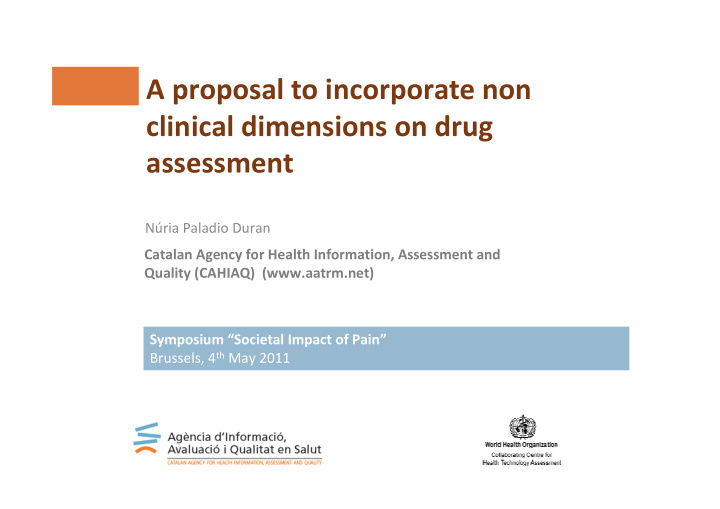



A proposal to incorporate non clinical dimensions on drug assessment Núria Paladio Duran Catalan Agency for Health Information, Assessment and Quality (CAHIAQ) (www.aatrm.net) Symposium “Societal Impact of Pain” Brussels, 4 th May 2011
Centralized Drug Review Clinical reviewers Economic Licensing agency reviewers Drug review Patients agency Public Local Local Local Typical payer payer payer Variable Source: Morgan S. Centre for Health Policy and Research
Drug approval vs reimbursement Different questions asked, diferent requirements have to be met: Marketing authorisation Can it work? Can it work? Does it work in practice? Does it work in practice? Is it worth it? Is it worth it? Reimbursemen t Haynes B. BMJ 319 : 652-3, 1999
Program for the assessment, monitoring and financing of high complexity treatments CatSalut (provider) Register Assessment Monitoring Financing (CAMUH) (CATFAC) (COPIF) [CAHIAQ]
CAMUH (Commision for the assessment of hospital use drugs) Provides CatSalut with recommendations on HCT: • Place in therapy • Use criteria (type of patient) • Response and follow-up criteria
CAMUH: Basic principles � Independency (assessment/appraisal separate processes) � Transparency (Public documents) � Credibility (Conflict of interest) � Rigorous methodology � Participation of stakeholders (entrega evidència i dret a apel·lació)
CAMUH: Basic structure Assessment Appraisal Decision Reviewers Committee CatSalut + Clinical experts + Manufacturers Recommendations are Final decision not binding
How does the process begin and what drugs are reviewed? Review process begins with: Request from CatSalut (provider) � CAMUH reviews: Biotech/biosimilar drugs � Drugs with conditional approval/approved in � exceptional circumstances Orphan drugs � Advanced therapies � High budget impact drugs �
Methods ����� 1. Objective definitions. 2. Assessment report 3. Dissemination Final report and appraisal Search strategies 6 1 External review Reference retrieval 5 (clinicians, manufacturers) 2 Analysis and data Data extraction and critical 4 synthesis (1st draft) appraisal 3 Time: 20 weeks maximum
Appraisal WTP: willingness to pay
Examples Main study Comparator Main efficacy results Safety Cost-effectiveness Idursulfase RCT Placebo 6MWT-FVC: significant No major concerns 564.000 £/QALY (phase II/III) improvement 6MWT : + 37 meters QoL: no data Lapatinib RCT Capecitabine TTP : 6,3 vs 4,3 months Hepatotoxicity 81.000 £/QALY (phase III) OS: no differences QoL: no differences Trabectedin RCT Dose TTP Hepatotoxicity No data (phase II) comparison (comparison btw Hematological (incremental cost: 12.000 € doses) toxicity compared to gemci/doce) ?
Dimensions Context Effficacy Safety QoL Effectiveness Health Externalities Innovation system Effect of illness Bias? Rate of AE? Availability of Availability of Cost- Repercussion of New mechanism of on patients QoL? data? data? efectiveness drug in other sectors action? Effect of illness Type of Rate of SAE? Specific/generic? In accordance Budget impact Introduction impacts New route of on patients QoL? variable? with efficacy? regional research? adminsitration? Therapeutic Follow-up? SAE related Instrument Equity Improved delivery? gap? to drug? validated? problems? Proximity to Estatistical Deaths Direction of Improved death? significance? related to results? disposition? drug? Clinical significance? 1. Identify the need for a new drug 2. Identify what benefits should a new drug satisfy 3. See if the claimed benefits of a new drug fulfill the predefined ones and at what cost
Examples Drug Context Effficacy Safety QoL Effectiveness Health Externalities Innovaction system MIGLUSTAT 3 3 4 5 3 5 0 5 VELAGLUCERASE 3 3 6 4 - 7 0 2 IMIGLUCERASE 3 3 4 5 3 5 0 5 PAZOPANIB 7 4 5 4 - 3 1 4 TRABECTEDIN 8 3 3 5 - 5 7 5 Miglustat Velaglucerase Imiglucerase
The relationship between social value and incremental cost per quality-adjusted life-year (QALY) Higher social value C A Lower Higher incremental cost incremental cost per QALY per QALY B Lower social value
CAMUH activity (Jan 2010-May 2011) Finished: … and working on: Idursulfase (MPS II) Tolvaptan (SIHAD) � � Agalsidase alfa (Fabry) � Larodinase (MPS I) Aztreonam (QF) � � Agalsidase beta (Fabry) � Galsulfase (MPS VI) Everolimus (RCCm) � � Conestat alfa (AE) � Miglustat (NPC) Ofatumumab (NHL) � � ChondroCelect (CL) � Eculizumab (PNH) Lapatinib (MBC) � � Pirfenidone (IPF) � Trabectedin (STS) Pazopanib (RCC) � � Cholic acid (IE) � Ambrisentan (PAH) Trabectedin (MOC) � � Azacitidine (MDS) � Amifampridine (LES) � Romiplostim (ITP) � Eltrombopag (ITP) � Plerixafor � (MM/NHL) ���������������������������������������������������������������������������
Conclusions � In a limited budget context priorization is needed � Centralised drug review processes and HTA are very useful to assist in making coverage decisions � Efficacy, safety and efficiency may not be sufficient to make reimbursement decisions � Social value of drugs is missing in the decision making process
HTA, Technologies and Choice
T H A N K Y O U . Catalan Agency for Health Information, Assessment and Quality (CAHIAQ) Barcelona-Catalonia-Spain www.aatrm.net Núria Paladio npaladio@aatrm.catsalut.cat ����������������������������������������������������������������������
Recommend
More recommend